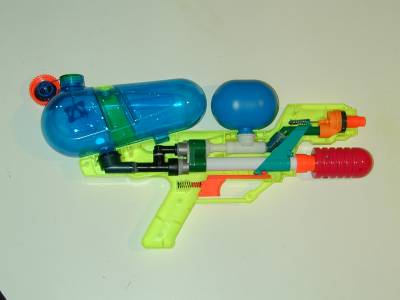In our years of playing with super soakers, we've taken many apart, and repaired many as well. In the process we've figured out (in large part) how super soakers work. No, it's not rocket science, but you might be interested in reading this if you don't have a gun that you'd like to dissect.
An air/water mix is pressurized in a rigid plastic tank. Pumping causes both air and water to be injected into this tank. Since the tank is fixed in size, and water does not change volume (appreciably) when under pressure, the air is what provides pressurization.

We have not yet disassembled the mechanism that mixes the water and air, but we're curious about how they constructed it.
Firing is accomplished through a simple valve that allows the contents of the pressurized tank to exit through a nozzle.
Imagine a tank half filled with water and pressurized air. The water is heavier, so it is on the bottom. At the bottom of this tank is a small hose which connects the it to the gun. Now, imagine holding the gun upside down. Instead of water being forced out of the reservoir by pressurized air, the air itself will leave the gun if fired. In other words, a gun of this class will have difficulty firing when not reasonably horizontal.
Air is not used to pressurize this mechanism. Instead, there is a flexible rubber chamber inside. Pumping the gun causes water to be forced into the rubber chamber. The chamber expands, and pressure is maintained due to the tension of the rubber chamber. Any air present in the chamber would only serve to reduce performance.

As you can see, the CPS mechanism is substantially simpler than the XP mechanism conceptually. It has some additional advantages: since the bladder contains only water, the gun can fire when held in any direction.
Mechanically, however, it poses some difficulties. It is probably impossible to form a seamless bladder that is strong enough. Larami decided to implement the bladder using a soft rubber tube with walls about 1/4" thick. It has seams, which pose a significant risk of failure. In addition, the tube must be plugged on one end. Larami plugs the interior of the plug with a piece of molded plastic, and holds it in place with plastic clamps on the outside of the tube. Unfortunately, the very act of pressurizing the gun works to slowly loosen the clamps, which can cause the plug to pop out of the tubing. Another problem is that any small defect in the rubber tubing could cause the tube to expand at different rates in different spots, which could lead to a failure.
To combat the last problem, as well as provide a layer of protection should the reservoir burst, Larami encloses the rubber reservoir in a rigid plastic (non air-tight) tube. This prevents any part of the rubber from expanding to a diameter larger than the plastic tube. The plastic tube would also presumably help absorb some of the energy of an explosion, should one occur.